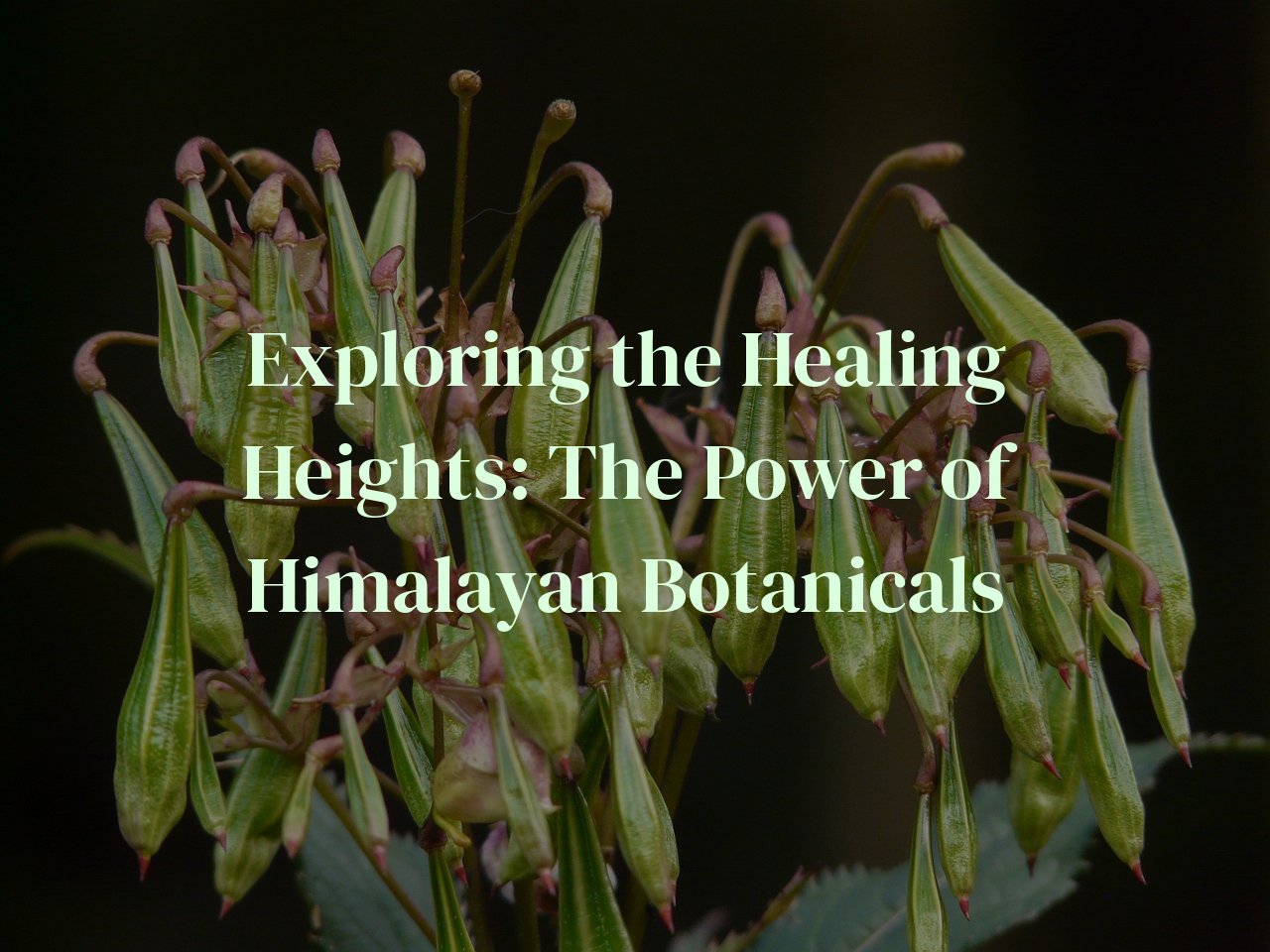
Embark on a journey of wellbeing as we delve into the verdant valleys and towering peaks of the Himalayas, home to some of the world’s most potent and least explored medicinal flora. This post is dedicated to shedding light on the extraordinary health benefits nestled within these rare Himalayan herbs, and how they can contribute to holistic healing and wellness. As we explore these enigmatic botanicals, readers will discover unique ways these plants can enhance their health, drawing from traditional practices and the latest scientific research. By the end of this article, a treasure trove of natural wellness strategies awaits, ready to enrich your health regimen and introduce you to the untapped wonders of Himalayan herbology.
Table of Contents
The Mysterious Mountain Medicine: A Primer
Immersed in the enigmatic beauty of the Himalayas, a treasure trove of medicinal herbs lies hidden, holding secrets to healing that have piqued the interest of healers and health-seekers for centuries. My journey through the steep terrains introduced me to a myriad of these botanical wonders, each with its unique story of therapeutic prowess.
Understandably, locals have revered the mystical Rhodiola Rosea or ‘golden root’ for its ability to enhance endurance and resilience to altitude sickness. This adaptogen, I learned, isn’t just folklore; athletes now pursue it for an extra edge. Crossing paths with the ancient Hippophae, commonly known as sea buckthorn, revealed a powerhouse of antioxidants, significantly improving cardiovascular health and skin radiance. A local woman, her cheeks as ruddy as the berries she picked, smiled as she explained how this plant fortified her against the harsh mountainous climate.
Curiosity led me to the elusive Yarsagumba, an astonishing fusion of caterpillar and fungus, treasured more than gold in some circles for its mythical aphrodisiacal and medicinal qualities. The blend of animal and plant intrigued researchers and laymen alike; however, its rarity underscored the importance of sustainable practices. Delving further into the verdant valleys, I stumbled upon the enchanting Viola Serpens, employed by nearby villagers to soothe aching throats and calm persistent coughs.
Each encounter with these Himalayan herbs was a revelation—anecdotal tales interwoven with emerging scientific validation, creating a compelling narrative for the modern seeker. This ancient mountain medicine, once shrouded in mystique, now gradually unfolds its potential, promising a resurgence of natural therapy in a world keen on holistic wellness.
Indeed, the Himalayas are not just majestic in their stature, but majestic too, in the healing potential that flourishes amidst their lofty reaches. As a passionate advocate for natural remedies, integrating these mountain medicines into daily health regimens has become a personal quest, and I’m eager to unlock more of their secrets in the pages to come.
Cultivating Wellness: Traditional Uses of Himalayan Herbs
The lush valleys and serene slopes of the Himalayas have long been a source of wonder, harboring botanical secrets passed down through generations. In this tranquil sanctuary of nature, traditional healers have turned to the earth’s verdant bounty for remedies, crafting wellness from the flora that thrives despite the harsh climes. My journey through verdant trails, led by the wisdom of local sages, offered insights into this ancestral practice of healing, grounded in a profound respect for the land.
One such plant, the elusive Yarsagumba (Ophiocordyceps sinensis), known also as the ‘Himalayan Viagra’, intrigued me with its dual identity as both fungus and caterpillar. This rare entomopathogenic marvel is reputed for its vitality-enhancing properties and locals harvest it with exceptional care, aware of its scarce nature. The path led me then to the ancient Seabuckthorn (Hippophae rhamnoides), whose berries, glowing like tiny orange suns, are rich in crucial nutrients and believed to promote skin health and boost immunity. Communities here have harnessed its power in creams, juices, and teas, their practices a testament to the plant’s enduring role in local healthcare.
Another herbal treasure, the Rhodiola rosea, breathes life as ‘golden root’ amidst rocky terrains. Consumed by sherpas to ward off altitude sickness, this adaptogen supports resilience against physical and mental stress. While the Spikenard (Nardostachys jatamansi), a fragrant healer, is delicately woven into the fabric of herbal medicine, offering solace as a sedative and a salve for the mind and spirit. The intertwining of such herbs within traditional wellness cannot be overstated; for each root and leaf harbors stories of healing that whisper the secrets of survival adapted over millennia.
Embracing the indigenous culture, I have witnessed firsthand, the reverent practice of wildcrafting Aconitum heterophyllum or ‘Atis’, an herb that challenges both the daring gatherer and practitioner with its dual nature of toxin and tonic, demanding expert knowledge for its use against fevers and digestive woes. Uncultivated nature offers the truest form of organic growth, where each Himalayan herb seemingly holds a pact with those who understand its essence – a symbiosis of life and health encased within leaves, petals, and roots.
Amidst these botanical curiosities, a phenomenon not just of healing but also of heritage unfolds. As each herb passes through the hands of the collector, into the mortar of the practitioner, and onto the lives of those it touches, it becomes clear that cultivating wellness is more than an art – it is a living dialogue between the mountains and the people who call them home. A thing of beauty and potency, the traditional use of Himalayan herbs is a mosaic of nature’s resilience and humanity’s inherent need to find balance within it.
Science Meets Nature: Evidence-Based Benefits
The confluence of modern science and ancient wisdom has sparked a growing interest in the therapeutic qualities of Himalayan botanicals. My journeys through these majestic mountains have instilled a deep respect for the symbiotic relationship between nature and health. It’s a connection that’s tangible in the whispers of the wind and the resilience of alpine herbs, thriving against all odds. Scientific studies are beginning to validate what local shamans have known for centuries.
Take for instance the mystical Rhodiola rosea, an adaptogenic marvel. Its roots, steeped in folklore, are believed to promote vitality and longevity. Clinical trials have illuminated its potential to enhance cognitive function and combat fatigue. This golden root isn’t just a tale from the ancients; it’s a beacon of modern-day stress relief.
Then there’s Hippophae rhamnoides, commonly known as sea buckthorn. This vibrant berry, laden with omega fatty acids, vitamins, and antioxidants, has made waves in the nutraceutical realm. Research reinforces its role in supporting heart health, skin vitality, and immune defense. It’s like capturing the sun’s energy in a little orange powerhouse.
The intriguing Withania somnifera, or ashwagandha, is another gem, a cornerstone of Ayurvedic medicine. Scientists are eagerly unpacking its adaptogenic secrets, uncovering evidence that it may aid in reducing anxiety and promoting restful sleep. This herb doesn’t just soothe the soul; it’s a hug from the earth, grounding us in tranquil reality.
The Himalayas hold more than just breathtaking vistas; they are a wellspring of healing. As someone who has felt the gentle embrace of this natural pharmacy, I can attest to the profound impact these botanicals can have. But our reverence for them is measured by the steps we take to ensure their sustainability, making certain that science and nature walk hand in hand for generations to come.
Incorporating Himalayan Herbs into Modern Diets
The integration of Himalayan herbs into contemporary meals doesn’t call for elaborate rituals or complicated recipes. As someone who cherishes the delicacy of flavors and the potency of nutrition in every herb, let me share ways to seamlessly fuse these botanical marvels into your daily eating habits.
Consider the versatile Shilajit, a mineral-rich resin lauded for its vigor infusing properties. A pea-sized portion dissolved in warm water or tea can revitalize your afternoons without a hint of artificial stimulants. The initially earthy taste might be peculiar for some, but when your energy levels surge, it becomes an acquired taste worth embracing.
Then there’s the calming Rhodiola, which I often turn to on tumultuous days. Infusing a teaspoon of its dried, powdered form into a cup of hot water, sipping it gently, always realigns my senses and boosts my mood. Anecdote aside, numerous enthusiasts claim it’s like a warm embrace in a mug.
Sea buckthorn is another gem that I’ve incorporated into my smoothies for a tangy twist—its berries burst with vitamin C. I often joke that if you could bottle sunshine, it would probably taste like sea buckthorn-infused smoothie. This Himalayan favorite not only elevates the flavor but brings a refreshing zest to my mornings.
The modest yet mighty fenugreek, though not endemic to the high altitudes, flourishes in the Himalayan soils, has found its way into my spice cabinet. A sprinkle of its ground seeds adds a nutty depth to my curries, while purportedly aiding digestion and sugar metabolism. An everyday spice, with not-so-everyday benefits.
Lastly, embracing sustainability is key. While we enrich our diets with these bounties, it’s crucial to support practices that ensure the longevity of these herbs. After all, incorporating Himalayan plants is more than a dietary enhancement—it’s about building a legacy of wellbeing and respect for the mountain’s natural treasures.
Sustainable Harvesting: Ensuring Future Generations Benefit
As dawn breaks over the rugged peaks of the Himalayas, I’m often reminded of how these ancient botanical specimens are as fragile as they are powerful. The very essence of sustainability lies in our hands, intertwining our destiny with these high-altitude healers. To truly harness the power of Himalayan botanicals, we must approach their harvest with reverence and foresight, ensuring their presence for centuries to come.
In my journey through the verdant valleys tucked amidst the Himalayan ranges, I’ve witnessed firsthand the delicate practices of sustainable harvesting. It’s often a dance, a balance, between the needs of today and the hope for tomorrow. One practice that left a lasting impression on me is the methodical collection, where healers carefully select only a specific portion of the plant, leaving the rest to regenerate and flourish. This is akin to taking a single leaf from a bountiful tree, knowing that this act of restraint is an investment in the tree’s future abundance.
Community-based conservation initiatives are commendable, uniting the wisdom of local populations with the necessity of preservation. These communities, with generational knowledge coursing through their veins, set quotas and guidelines that ensure only a sustainable number of plants are harvested each season. This collaborative effort protects the delicate ecosystem while empowering locals economically and fostering stewardship of the land.
Another approach that has touched my conscience is the cultivation of Himalayan herbs in controlled environments. Greenhouses and herbal gardens mimic the high-altitude conditions, becoming sanctuaries for vulnerable species. These methods provide a buffer, safeguarding wild populations from over-harvesting, which can lead not only to the extinction of the plant species but also to the diminishment of the healing knowledge associated with them.
The journey of these herbs from mountainside to modernity must be paved with responsibility. As I converse with fellow cultivators, I’m often struck by their relentless pursuit to innovate harvesting techniques that align with nature’s rhythms rather than disrupt them. By planting more than we pick, engaging in seed scattering endeavors, and meticulously monitoring the growth and health of harvested areas, the Himalayan communities are envisioning a legacy that transcends the immediacy of commerce.
My heart is imbued with hope when I think of the Himalayan botanicals. Their ability to heal and nurture is a testament to nature’s boundless gifts. Through sustainable harvesting, we’re not only unlocking the therapeutic potential of these rare herbs for ourselves but also safeguarding a natural heritage, a verdant legacy whispering the secrets of vitality to future generations.
Conclusion
In the majestic shadows of the Himalayas, we have uncovered a handful of nature’s best kept secrets. The potential woven into the essence of Himalayan herbs holds promising avenues for natural health practices. While the world continues to advance with modern medicine, the integration of these rare herbs into our daily lives offers a complementary path to well-being. Whether you are an avid natural health enthusiast or newly embarking on a journey of holistic wellness, let these insights inspire your quest for a more balanced and harmonious existence.



